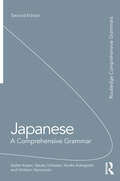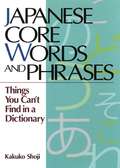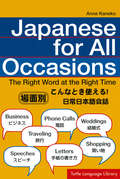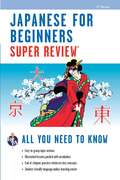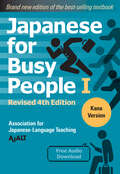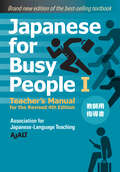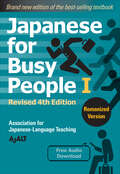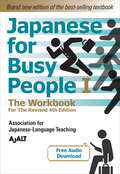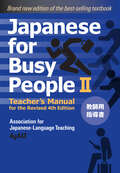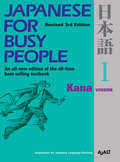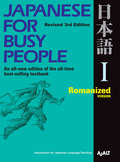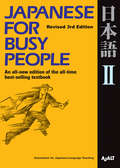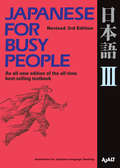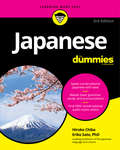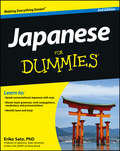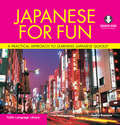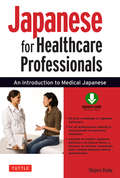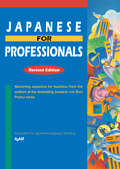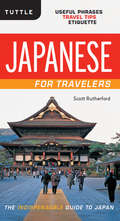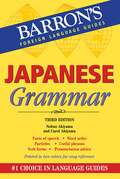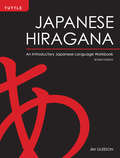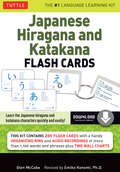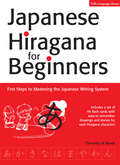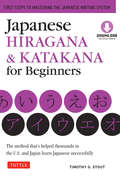- Table View
- List View
Japanese: A Comprehensive Grammar (Routledge Comprehensive Grammars Ser.)
by Stefan Kaiser Yasuko Ichikawa Noriko Kobayashi Hilofumi YamamotoJapanese: A Comprehensive Grammar is a thorough reference guide to modern Japanese grammar. With its detailed treatment of all grammatical structures, it explores the complexities of the language fully, concentrating on the real patterns of use in contemporary Japanese as spoken and written by native speakers. This edition has been fully updated throughout, incorporating a new structure now organised by topic and providing specific attention to areas of particular difficulty. Examples have been updated throughout to reflect current usage and a glossary of linguistic terms has been added. Features include: Clear grammar points put into context using examples from a range of Japanese media Inclusive coverage of both colloquial and standard Japanese Extensive cross-referencing in all parts of the book A detailed index of Japanese and English terms Written by experts in this field, Japanese: A Comprehensive Grammar will be an essential reference source for the learner and user of Japanese at all levels.
Japanese Core Words and Phrases: Things You Can't Find in a Dictionary
by Kakuko ShojiSome Japanese words and phrases, even though they lie at the core of the language, forever elude the student's grasp. They are not explained satisfactorily in dictionaries or textbooks for the simple reason that they cannot be conveniently defined. Japanese Core Words and Phrases brings these recalcitrants to bay.The book is divided into two parts, each of which is arranged in alphabetical order. The first part is devoted to words indicating physical as well as psychological distance—roughly equivalent to "this," "that," "that over there," and "where," but quite different in usage. Physical distance is covered in most textbooks, but psychological distance—every student's nemesis—is not.The second part of the book covers a variety of idiomatic expressions, many of which appear in Japanese proficiency tests. Each entry word or phrase is not simply explained but exemplified in sentence form, clarifying its meaning (in the case of many students) for the very first time.Japanese Core Words and Phrases has a great deal to offer the beginning student and much to offer the intermediate student. Little more can be asked of a book on the Japanese language.Previously published in the Power Japanese series as Core Words and Phrases: Things You Can't Find in a Dictionary.
Japanese for All Occasions
by Anne Kaneko Sally MotomuraAt last. A book of useful Japanese, offering the language you need to handle a wide variety of situations. Through hundreds of example sentences and dialogues, you'll learn what to say and do when:Setting up a business appointmentOpening a bank accountMaking a wedding speechReserving a place to stayRenewing a visaand much moreIncluded is an additional chapter on writing cards and letters, featuring examples of New Year cards, thank-you notes, and normal letters.No other book covers colloquial Japanese as thoroughly as Japanese for All Occasions. Whether you're a student, traveler, or businessperson, you'll find that this book offers any easy and enjoyable way to improve your Japanese.
Japanese for Beginners Super Review - 2nd Ed. (Super Reviews Study Guides)
by The Editors of REAREA's Japanese for Beginners Super ReviewGet all you need to know with Super Reviews!2nd EditionREA's Japanese for Beginners Super Review contains an in-depth review that explains everything high school and college students need to know about the subject. Written in an easy-to-read format, this study guide is an excellent refresher and helps students grasp the important elements quickly and effectively.Our Japanese for Beginners Super Review can be used as a companion to high school and college textbooks, or as a handy resource for anyone who wants to improve their Japanese language skills and needs a fast review of the subject.Presented in a straightforward style, our review covers the material taught in a beginning-level Japanese language course, including: vocabulary, speech patterns, useful expressions, and more. Each illustrated lesson includes exercises to help students review what they've learned.
Japanese for Busy People Book 1: Revised 4th Edition (Japanese for Busy People Series)
by AJALT4th Revised Edition of JAPANESE FOR BUSY PEOPLE, the most popular Japanese language textbook series in the world. Since it was first published in 1984, the focus of the Japanese for Busy People series has always been to teach Japanese for effective communication. As suggested in the title, this is a concise course for busy students who want to learn natural, spoken Japanese as efficiently as possible in a limited amount of time. The new Japanese for Busy People: Revised 4th Edition is made up of three volumes: Book I, Book II, and Book III. Book I is available in both romanized and kana versions, similar to the Revised 3rd Edition. The Kana Version is exactly the same as the Romanized Version except for the scripts used throughout the book: hiragana and katakana. The Kana Version is therefore recommended for those who have already learned kana (as these scripts are collectively called) or are learning them with Japanese for Busy People Kana Workbook or another such text. Studying Japanese in kana, rather than in romanized script, can lead to fluent pronunciation and facilitate a smooth transition to the study of kanji.
Japanese for Busy People Book 1: Revised 4th Edition (Japanese for Busy People Series)
by AJALTJapanese for Busy People is the most popular Japanese language textbook series in the world. Japanese for Busy People series is one of the most comprehensive series containing texts, workbooks and teacher&’s manuals for all three volumes. Audio recordings for the dialogues and listening exercises are now available as free download from kodansha.us. Teacher&’s Manual provides specific suggestions for teachers on how to use the main text in a classroom setting and how to coordinate it with the workbook. CAN-DO section is useful in creating lesson plan and measuring learners&’ mastery level. It also contains a Japanese translation of all of the key components of the main text, such as culture notes, notes on Japanese grammar, and active communication. This first of three volumes introduces "survival Japanese" — the absolute minimum amount of Japanese needed to live in Japan. Thus, the vocabulary and grammatical items it introduces are limited to about a third of what is typically introduced in a first-year course. In addition, the book features notes on Japanese culture intended to expand the learner&’s understanding of Japan, its customs and people. Japanese for Busy People I is available in two formats: romanized and kana. The Romanized Version uses romanized Japanese throughout, with kana in the Opening Dialogues of each lesson. The Kana Version — exposing students to hiragana and katakana from the very beginning — uses only kana.The content of the two books is otherwise exactly the same. The companion volume, Japanese for Busy People 1: The Workbook for the Revised 4th Edition contains a variety of illustrated exercises for mastering the basic sentence patterns presented in the main text.
Japanese for Busy People Book 1: Revised 4th Edition (Japanese for Busy People Series)
by AJALT4th Revised Edition of JAPANESE FOR BUSY PEOPLE, the most popular Japanese language textbook series in the world.Since it was first published in 1984, the focus of the Japanese for Busy People series has always been to teach Japanese for effective communication. As suggested in the title, this is a concise course for busy students who want to learn natural, spoken Japanese as efficiently as possible in a limited amount of time.The new Japanese for Busy People: Revised 4th Edition is made up of three volumes: Book I, Book II, and Book III. Book I is available in both romanized and kana versions, similar to the Revised 3rd Edition.The Romanized Version uses romanized Japanese throughout, with kana in the Target Dialogues of each lesson.
Japanese for Busy People Book 1: Revised 4th Edition (Japanese for Busy People Series)
by AJALT4th Revised Edition of JAPANESE FOR BUSY PEOPLE, the most popular Japanese language textbook series in the world. Since it was first published in 1984, the focus of the Japanese for Busy People series has always been to teach Japanese for effective communication. Japanese for Busy People I: The Workbook for the Revised 4th Edition is for all learners who wish to improve their speaking and listening skills. It can be used in tandem with Japanese for Busy People I: Revised 4th Edition, both Kana Edition and Romanized Edition, or as independent study material. The workbook provides ample speaking and listening practice in the form of illustrated exercises that call on learners to construct dialogues and role-play in Japanese. Illustrations combined with conversations, which proceed at a natural pace in the audio recordings, help learners to feel as if they are actually experiencing each situation. Through repeated oral and listening practice, learners will come to acquire the rhythm of real-life Japanese conversation. Audio recordings can be downloaded for free from kodansha.us.
Japanese for Busy People Book 2: Revised 4th Edition (Japanese for Busy People Series)
by AJALTThe Teacher&’s Manual provides specific suggestions for teachers on how to use Japanese for Busy People Book II in a classroom setting and how to coordinate it with the workbook. CAN-DO section is useful in creating lesson plan and measuring learners&’ mastery level. It also contains a Japanese translation of all of the key components of the main text, such as culture notes, notes on Japanese grammar, and active communication.
Japanese for Busy People I: Kana Version (Japanese for Busy People Series)
by AJALTJapanese for Busy People is the most popular Japanese language textbook series in the world. With over 20 components including texts, workbooks, CDs, videos and teacher&’s manuals, it is also one of the most comprehensive. Now, a decade after its first revision, the entire series is being redesigned, updated and consolidated to meet the needs of 21st-century students and businesspeople who want to learn natural, spoken Japanese as effectively as possible in a limited amount of time.The book features not only a sleek, new design but also a unit structure that groups thematically linked lessons together, making it easier than ever to learn Japanese. Moreover, it now comes with a CD containing audio for the dialogues and listening exercises from the text. The exercises in the book have also been thoroughly revised to incorporate more comprehension and production tasks. Many of these exercises are illustrated, making for a stimulating learning experience, and the purpose of each one is clearly stated.This first of three volumes introduces "survival Japanese" — the absolute minimum amount of Japanese needed to live in Japan. Thus, the vocabulary and grammatical items it introduces are limited to about a third of what is typically introduced in a first-year course. In addition, the book features notes on Japanese culture intended to expand the learner&’s understanding of Japan, its customs and people.Japanese for Busy People I is available in two formats: romanized and kana. The Romanized Version uses romanized Japanese throughout, with kana in the Opening Dialogues of each lesson.The Kana Version — exposing students to hiragana and katakana from the very beginning — uses only kana.The content of the two books is otherwise exactly the same.The companion volume, Japanese for Busy People 1: The Workbook for the Revised 3rd Edition contains a variety of illustrated exercises for mastering the basic sentence patterns presented in the main text.
Japanese for Busy People I: Romanized Version (Japanese for Busy People Series #1)
by AJALTJapanese for Busy People is the most popular Japanese language textbook series in the world. With over 20 components including texts, workbooks, CDs, videos and teacher&’s manuals, it is also one of the most comprehensive. Now, a decade after its first revision, the entire series is being redesigned, updated and consolidated to meet the needs of 21st-century students and businesspeople who want to learn natural, spoken Japanese as effectively as possible in a limited amount of time.The book features not only a sleek, new design but also a unit structure that groups thematically linked lessons together, making it easier than ever to learn Japanese. Moreover, it now comes with a CD containing audio for the dialogues and listening exercises from the text. The exercises in the book have also been thoroughly revised to incorporate more comprehension and production tasks. Many of these exercises are illustrated, making for a stimulating learning experience, and the purpose of each one is clearly stated.This first of three volumes introduces "survival Japanese" — the absolute minimum amount of Japanese needed to live in Japan. Thus, the vocabulary and grammatical items it introduces are limited to about a third of what is typically introduced in a first-year course. In addition, the book features notes on Japanese culture intended to expand the learner&’s understanding of Japan, its customs and people.Japanese for Busy People I is available in two formats: romanized and kana. The Romanized Version uses romanized Japanese throughout, with kana in the Opening Dialogues of each lesson.The Kana Version — exposing students to hiragana and katakana from the very beginning — uses only kana.The content of the two books is otherwise exactly the same.The companion volume, Japanese for Busy People 1: The Workbook for the Revised 3rd Edition contains a variety of illustrated exercises for mastering the basic sentence patterns presented in the main text.
Japanese for Busy People II: Revised 3rd Edition (Japanese for Busy People Series)
by AJALTVolume I dealt with "survival Japanese" for tourists and other short-term travelers and newcomers to Japan. Volume II, meanwhile, turns to the basics of Japanese syntax. The book is by no means only about grammar, however. Rather, it is designed to help learners consolidate their understanding of syntactical structure through lessons that focus on how to talk about topics relevant to daily life. In addition to serving learners continuing from Volume I, Volume II will benefit those who have already studied beginning Japanese to some extent but wish to brush up on syntax. Major Features of Japanese for Busy People II, Revised 3rd Edition, will enable learners to progress smoothly through the equivalent of the latter half of a typical first-year Japanese course while gradually building speaking and listening skills. Learners approaching mid-beginner status often find themselves suddenly faced with syntax and vocabulary much more complex than what they have studied before. Such grammar and vocabulary do not appear as frequently in everyday conversation as those words and structures they have learned up to this point, necessitating that they spend ample time on review. Moreover, learners at this stage are expected to become familiar with verb tense and aspect, time expressions, conditional clauses, and other topics that require them to have a solid grasp of context and speaker intent if they are to fully understand the differences in meaning conveyed by each. Japanese for Busy People II helps overcome the above obstacles through grammar and content topics carefully selected to be appropriate to learners at this level of Japanese proficiency. The book is designed so that by practicing talking about each topic, learners will gradually and effectively acquire sentence patterns and vocabulary related to that topic. Like Volume I, Volume II is organized into several large units, each covering topics grouped under a particular theme. In this way, the book enables learners to achieve a well-balanced understanding of grammar, sentence structure, and context.
Japanese for Busy People III: Revised 3rd Edition (Japanese for Busy People Series)
by AJALTBuilding on the grammar and vocabulary presented in Volume II, Japanese for Busy People III will enable readers to initiate, sustain, and close most basic conversations. With numerous speaking, listening, reading and writing tasks. quizzes and illustrations to make the learning process both fun and effective, this book prepares readers for Level 3 of the Japanese Language Proficiency Test.
Japanese For Dummies (For Dummies)
by Hiroko M. Chiba Eriko SatoLearn to speak Japanese Japanese language enrollment is up by 27.5 percent since 2006, making it the sixth most popular language studied on college campuses. Whether studying for school, business, or travel, Japanese For Dummies provides complete coverage of all Japanese language essentials including grammar, usage, and vocabulary. Complete with free conversational audio tracks online, this handy book offers everything you need to learn the Japanese language to get ahead in class or on a trip to Japan. In no time, you’ll make sense of the language well enough to communicate with native speakers! Includes expanded coverage of grammar, verb conjugations, and pronunciations Provides a refreshed mini-dictionary with even more essential vocabulary Offers useful exercises and practice opportunities Helps you learn to speak conversational Japanese with ease Whether for work, school, or fun, Japanese For Dummies is the fast and easy way to add this language to your skillset!
Japanese For Dummies
by Eriko SatoJapanese is a wonderful language, very different from European languages. It is also the gateway to the rich culture of the exciting and complex island nation of Japan. Some people get intimidated by the prospect of speaking Japanese--worried that it's just too complex and different--but these fears are unfounded. While you can devote a lifetime to the study of this or any language, picking up the basics of Japanese doesn't require any more than an interest and a willingness to try something new.Japanese For Dummies has everything you need to get off the ground with speaking the language. Author and Professor of Japanese Eriko Sato starts you off with the essentials of grammar and pronunciation, giving you a working sense of the language, before showing you Japanese in action. You'll then explore vocabulary and expressions through dialogues taking place in situations such as:Introductions and greetingsEating and drink ingShoppingExploring the townTalking on the telephoneAsking directionsGetting aroundStaying at a hotelYou'll also discover social customs, formalities, and manners, from how and when to bow to how to unwrap a present. Whether you simply want to introduce yourself to the Japanese language, say a few words to a neighbor or coworker, or you're planning a major trip or study abroad in Japan, Japanese For Dummies will enable you to get the basics fast and work towards your own goal at your own pace. You'll also find out about:How to use karaoke to help you learn JapaneseMovies that will introduce you to Japanese culture and languageLearning Japanese the "gourmet" wayWhen ignoring "no, thank you" shows good mannersProper table mannersProper body languageHow to sound fluentAnd much more!With helpful vocabulary summaries, a mini-dictionary at the end, and an audio CD full of conversations and pronunciations, Japanese For Dummies assumes no prior knowledge of Japanese on your part--providing the perfect guide for a quick-but-thorough, lighthearted-but-not-lightweight introduction to the language.
Japanese for Fun: A Practical Approach to Learning Japanese Quickly
by Taeko KamiyaThis is a concise guide to learning basic Japanese.This pocket book is intended for people who want to learn Japanese quickly. <P><P> Whenever you have a few minutes- waiting in a hotel lobby, riding on a train, or whatever-open this book and you can learn phrases you'll use again and again during your stay in Japan. The book is divided into twenty-one chapters, each covering a specific topic. Each chapter includes the following three sections:Words & Expressions: This section introduces words and expressions needed in specific situations. Vocabulary is presented systematically for quick and easy understanding.Expressions in Context: This shows how to use in context the words and expressions given in the preceding section. Gives you confidence in using new words in original sentences.Additional Words & Expressions: This section enables you to create many new sentences using the patterns just learned. There's no need to memorize all the words or phrases presented here: concentrate on just those you want to use.To use this book, start by reading the first three chapters of the book. These introduce many of the most commonly used words and phrases, and familiarize you with the basic sentence structures. After Chapter
Japanese for Healthcare Professionals
by Shigeru OsukaThe only book of its kind in English,Japanese for Healthcare Professionals is a proficiency-based conversation textbook offering a complete Japanese language course that teaches Japanese grammar along with the vocabulary of medical care. With nearly three million Japanese tourists visiting the United States last year, and another five hundred thousand expatriates residing in the US and other English-speaking countries, it is inevitable that many Japanese speakers find themselves in need of healthcare but unable to communicate. Important highlights of this book are: Contains accompanying MP3 Audio Disc. No prior knowledge of Japanese necessary. For all professionals seeking to communicate in healthcare situations. Includes an English–Japanese dictionary of medical terms, a glossary of common complaints, and a sample bilingual medical questionnaire. Japanese for Healthcare Professionals offers a complete language course—for classroom study or independent learners that teaches Japanese grammar along with the medical Japanese vocabulary. The chapters cover every step of a patient's interaction with care providers, from appointments and admissions to the physical examination, symptoms and illnesses, diagnosis, treatment, instructions to the patient, discharge, and follow–up. Chapters are devoted to the major branches of medicine as well as dentistry and to the corresponding bodily systems. There are also chapters on anatomy, infection and disease, and visits to the pharmacy. Each Chapter follows a natural progression designed to help the learner comprehend the new material and acquire the language as effortlessly as possible. Each includes: basic Japanese vocabulary, a situational dialogue, Japanese grammar points and key Japanese language and culture notes, exercises and practice drills, and a quiz to sharpen comprehension. The culture and language notes seek to help the provider understand better a Japanese patient's cultural framework and patterns of belief, as well as the "ultraslatable" meaning conveyed by certain idioms. The accompanying MP3 audio disc tries ties in core parts of each chapter, allowing learners to practice their spoken language skills outside a classroom setting. The book also includes thirty illustrations to help with vocabulary acquisition, a pronunciation guide, an English–Japanese dictionary of medical terms, a glossary of Japanese expressions for common complaints, a sample bilingual medical questionnaire, and answers to the quizzes. Emphasizing the learner's practical use of the Japanese language for healthcare settings is the importance of culture in understanding,Japanese for Healthcare Professionals reflects the national standards in foreign–language education set by theAmerican Council on the Teaching of Foreign languages (ACTFL).
Japanese for Professionals: Mastering Japanese for business from the authors of the bestselling JAPANESE FOR BUSY PEOPLE series
by AJALTFrom the authors of the best-selling Japanese for Busy People series comes a must have for intermediate and advanced learners who want to focus on building business Japanese language skills.The Association for Japanese-Language Teaching (AJALT), renowned for its Japanese for Busy People series, has developed a comprehensive course for students who need to use Japanese in a real-life business environment.Almost a decade after its first edition, Japanese for Professionals has been revised and updated to reflect current business scenes. Moreover, learners can now practice their listening skills with the newly added audio for the dialogues and exercises from the text.Eight lessons introduce common business situations with the emphasis on how to communicate with Japanese colleagues and clients. Each lesson is consisted with two parts: Part 1 is set to observe the dialogue and Part 2 is set to further enhance comprehension of the dialogue with exercises.Precise definitions for all new vocabulary and lucid explanations of grammar, idioms, and cultural differences provide the reader with powerful communication tools for the office. Exercises and quizzes have been included to help students check their progress. Busy professionals will find the bilingual glossaries a useful reference even after completing all the lessons in this clear and extremely helpful textbook.Japanese for Professionals is specially designed for learners who are familiar with basic Japanese and ideally be at level N2 or N3 of JLPT, Japanese-Language Proficiency Test.
Japanese for Travelers: Useful Phrases Travel Tips Etiquette (Japanese Phrasebook)
by Scott RutherfordThis ebook is a combination Japanese phrase book, Japanese travel guide and Japanese etiquette guide. <P><P>Packed with expressions and information for everyday occasions (looking for a place to stay, eating at a restaurant, making a telephone call), as well as less common ones (what to do if you become ill or something is lost or stolen), Japanese for Travelers allows you to break out of the role of passive spectator during your time in Japan and allow you to speak Japanese with locals. Helpful illustrations demystify Japan's sometimes intimidating rail system and provide handy information of ferry travel as well. The text offers travel tips ranging from where to go for a cheap, comfortable night's sleep (you'd be surprised) to whom not to stand behind when in line at customs.A breed apart from run-of-the mill Japanese phrasebooks, Japanese for Travelers is a tool for the traveler who is out not only to survive, but succeed, while staying in Japan. Sections include:Basic CommunicationMoneyMailGetting aroundEating and restaurantsLodgingLeisureDealing with problems such as illness
Japanese Grammar (Barron's Grammar Ser.)
by Nobuo Akiyama Carol AkiyamaA Simon & Schuster eBook. Simon & Schuster has a great book for every reader.
Japanese Hiragana
by Jim GleesonThis workbook has been carefully designed to facilitate the quick and easy mastery of the forty-six character hiragana syllabary used to write all types of native words not written in kanji.Each character is introduced here with brushed, handwritten, and typed samples to enhance character recognition. Entertaining illustrations and amusing examples of onomatopoeic usage of hiragana in Japanese writings further reinforce memorization in a fun way.This easy-to-use and practical workbook is well suited for beginning students of all ages. This revised edition has 16 more pages of exercises and additional practice pages.
Japanese Hiragana
by Jim GleesonThis workbook has been carefully designed to facilitate the quick and easy mastery of the forty-six character hiragana syllabary used to write all types of native words not written in kanji.Each character is introduced here with brushed, handwritten, and typed samples to enhance character recognition. Entertaining illustrations and amusing examples of onomatopoeic usage of hiragana in Japanese writings further reinforce memorization in a fun way.This easy-to-use and practical workbook is well suited for beginning students of all ages. This revised edition has 16 more pages of exercises and additional practice pages.
Japanese Hiragana and Katakana Flash Cards Kit
by Emiko Konomi Glen MccabeLearning to recognize and pronounce the basic hiragana and katakana phonetic alphabets is the first step in studying the Japanese language.<P><P>This set of 200 flash cards along with accompanying booklet, wall charts, and audio disc contains everything you need to quickly gain mastery of the two Japanese syllabaries and is a great way to learn Japanese. Frequent review is the key to memorizing the characters, and these cards are easily carried in a pocket or purse for a quick review session anytime.This box contains: 200 hole-punched flash cards with an organizing ring. Two 24" x 18" wall charts showing all hiragana and katakana. Native-speaker audio recordings of 1,128 words and phrases. 32-page study booklet with indexes and practice tips.Also available from Tuttle Publishing, Japanese Kanji Flash Cards Kit can be used alongside these flash cards to master written Japanese.
Japanese Hiragana for Beginners: First Steps to Mastering the Japanese Writing System
by Timothy G. StoutLearn how to write all the basic Japanese hiragana with this user-friendly workbook.<P><P>Japanese Hiragana for Beginners makes learning hiragana fast and effective by using memorable picture mnemonics, along with clear explanations, examples and lots of fun exercises-a method that has helped thousands of students learn hiragana successfully in the United States and Japan. Picture mnemonics enhance memory by associating the shape and sound of each hiragana character with combinations of images and English words already familiar to students.This Japanese language learning book is divided into three main sections: Section 1 introduces the basic 46 hiragana characters along with writing tips and practice exercises. Section 2 teaches the usage rules that allow students to write Japanese sounds. Section 3 strengthens students' skills through a wide range of exercises (word searches, crossword puzzles, fill in the blanks, visual discrimination, timed quizzes, etc).A set of flash cards printed on perforated cardstock and a list of suggested flash card activities, are also provided at the end of the book. Each of these cards introduces a hiragana character along with picture mnemonic that helps to recognize and remember it.
Japanese Hiragana & Katakana for Beginners
by Timothy G. StoutThe method that's helped thousands in the U.S. and Japan learn Japanese successfully.Japanese has two basic writing systems, hiragana and katakana, in addition to the one that uses Chinese characters or Kanji. <P><P> This handy book teaches you a new mnemonics-based method to read and write the basic 92 hiragana and katakana characters.Memorable picture mnemonics help you to learn the characters by associating their shapes and sounds with combinations of images and English words already familiar to you.Clear examples and entertaining exercises offer opportunities to read, write, use and practice all 46 basic hiragana and 46 basic katakana characters, plus the remaining kana that stand for more complex sounds.Polish your knowledge with word searches, crossword puzzles, fill-in-the-blanks, timed recognition quizzes, and other interesting activities.The Downloadable Content allows you to print out your own flash cards (featuring the same mnemonic images taught in the book) to help you review and practice, even while you're on the go.
